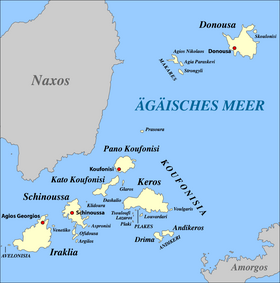Lesser East Cyclades
History
During the last ice age most of the islands of the Cyclades were united into a big landmass. After the sea level rose in ca. 9,000 B.C. the Aegean flooded the landmass to form the many small islands: this is when the archipelago acquired its modern form.
The Lesser Cyclades have been inhabited since the Stone Age. The islands flourished during the early Bronze Age, when the Cycladic culture appeared. The island of Keros was one of the major sites of Cycladic culture and has given its name to Early Cycladic II period of Cycladic culture, known as Keros-Syros culture. The islands continued to be populated thereafter. On the islands, particularly on Schoinoussa and Irakleia, ruins from classical antiquity and the Roman period can be found. The islands suffered from piracy both in medieval and modern times, which lead the islands to be at turn depopulated and colonised again by shepherds from Amorgos. Since the 11th century most of the islands of the Lesser Cyclades were given as property to the Hozoviotissa Monastery in Amorgos. The monastery even today retains large areas in the islands as its property. The islands today have been developed as a popular tourist destination.

Main islands
| Island | Area (Km) | Population (2011) |
|---|---|---|
| Irakleia | 18.1
|
141
|
| Keros | 15.0
|
0
|
| Donousa | 13.7
|
167
|
| Schoinoussa | 8.1
|
256
|
| Ano Koufonisi | 5.8
|
399
|
| Kato Koufonisi | 3.9
|
0
|
| Ano Antikeri | 1.1
|
0
|
| Kato Antikeri | 1.1
|
2
|
References
- ^ "Μικροί παράδεισοι στην καρδιά των Κυκλάδων". imerisia.gr. Retrieved 4 July 2015.
- ^ "Geomorphology". ime.gr. Retrieved 4 July 2015.
- ^ "The Bronze Age". fhw.gr. Retrieved 4 July 2015.
- ^ "History Culture". smallcyclades.com. Retrieved 4 July 2015.
- ^ "Που απλώνεται η ακίνητη περιουσία της Ι.Μ. Χοζοβιώτισσας". cycladesvoice.gr. Retrieved 4 July 2015.